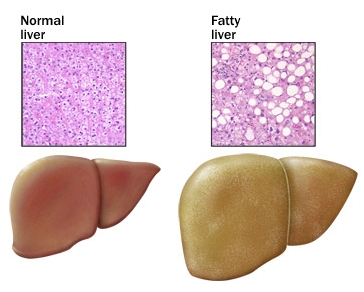Fatty Liver

Hepatosteatosis, Steatohepatitis
Fatty liver is the accumulation of fat in liver cells. It is also called hepatosteatosis or steatohepatitis. It is normal for your liver to contain some fat. If fat is more than 5-10% of your liver's weight, you have fatty liver.
There are often no symptoms (problems) for years while damage is still occurring.
People often learn about their fatty liver when they have medical tests for other reasons.
Fat can damage your liver for years or even decades without causing problems. When it becomes severe, it can cause fatigue, weight loss, weakness, and confusion.
This makes you more likely to develop more serious liver problems. The liver is the largest organ in the body. It does a lot of work and often gives no warning signs when it is sick until late in a disease.
The liver has many important jobs including:
• Breaking down foods.
• Storing vitamins, iron, and other minerals.
• Making proteins.
• Making bile for food digestion.
• Breaking down many products including medications, alcohol and some poisons.
Causes
There are a number of different conditions, medications, and poisons that can cause a fatty liver. Eating too many calories causes fat to build up in the liver. Not processing and breaking fats down normally may also cause this. Certain conditions, such as obesity, diabetes, and high triglycerides also cause this. Most fatty liver patients tend to be middle-aged and over weight.
Some causes of fatty liver are:
|
|
|
|
Some people develop fatty liver even having none of these conditions.
Symptoms
Fatty liver most often causes no problems. This is called asymptomatic.
• It can be diagnosed with blood tests and also by a liver biopsy.
• It is one of the most common causes of minor elevations of liver enzymes on routine blood tests.
• Specialized Imaging of the liver using ultrasound, CT (computed tomography) scan, or MRI (magnetic resonance imaging) can suggest a fatty liver but a biopsy is needed to confirm it.
• A biopsy involves taking a small sample of liver tissue. This is done by using a needle. It is then looked at under a microscope by a specialist.
Treatment
 It is important to treat the cause. Simple fatty liver without a medical reason may not need treatment.
It is important to treat the cause. Simple fatty liver without a medical reason may not need treatment.
• Weight loss, fat restriction, and exercise in overweight patients produces inconsistent results but is worth trying.
• Fatty liver due to alcohol toxicity may not improve even with stopping drinking.
• Good control of diabetes may reduce fatty liver.
• Lower your triglycerides through diet, medication or both.
• Eat a balanced, healthy diet.
• Increase your physical activity.
• Get regular checkups from a liver specialist.
• There are no medical or surgical treatments for a fatty liver or NASH, but improving your diet and increasing your exercise may help prevent or reverse some of the damage.
Prognosis
Fatty liver may cause no damage or it can lead to an inflammation of the liver. This is, called steatohepatitis. When it is linked to alcohol abuse, it is called alcoholic steatohepatitis. It often is not linked to alcohol. It is then called nonalcoholic steatohepatitis, or NASH. Over time the liver may become scarred and hardened. This condition is called cirrhosis. Cirrhosis is serious and may lead to liver failure or cancer. NASH is one of the leading causes of cirrhosis. About 10-20% of Americans have fatty liver and a smaller 2-5% has NASH.

